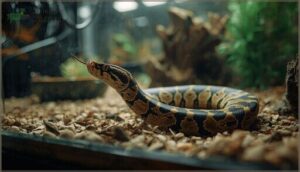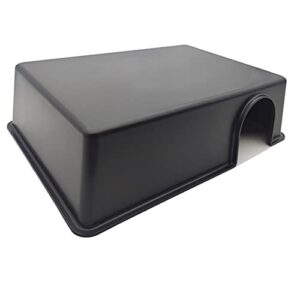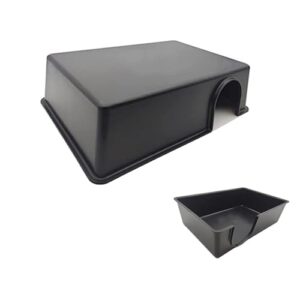This site is supported by our readers. We may earn a commission, at no cost to you, if you purchase through links.
Your ball python pressed against the glass at 2 AM isn’t admiring the view—it’s testing for weaknesses in your enclosure setup. Escape attempts aren’t random acts of reptilian rebellion; they’re deliberate responses to specific environmental triggers that keepers often overlook.
When humidity drops below 50%, when temperatures swing more than 3°C in a day, or when feeding schedules stretch past 10 days, your snake shifts into survival mode. These behaviors mirror what ball pythons do in the wild when conditions become inhospitable, except they can’t simply relocate to a better microclimate.
Understanding why ball pythons try to escape means recognizing the gap between their instinctual needs and what their captive environment provides, then systematically closing that gap before stress manifests as persistent pacing, nose rubbing, or successful breakouts.
Table Of Contents
- Key Takeaways
- Why Ball Pythons Try to Escape
- Environmental Stressors Affecting Ball Pythons
- Signs Your Ball Python is Unhappy
- Common Enclosure Mistakes Leading to Escapes
- The Role of Feeding and Enrichment
- Top 5 Products to Prevent Ball Python Escapes
- When to Seek Veterinary or Expert Help
- Frequently Asked Questions (FAQs)
- Do ball pythons try to escape?
- How to prevent ball pythons from falling?
- Why is my ball python stretching up towards the top?
- What do ball pythons do at night?
- What happens if you feed a ball python too small?
- How do you handle a ball python?
- How to keep ball python from escaping?
- Why is my snake not eating and trying to escape?
- Is it normal for my ball python to try to escape?
- What to do if my ball python escapes?
- Conclusion
Key Takeaways
- Ball pythons escape when environmental conditions fall outside critical thresholds—humidity below 50%, temperature swings exceeding 3°C daily, or feeding intervals beyond 10 days trigger survival-mode behaviors that manifest as persistent pacing and glass-surfing.
- Inadequate enclosure design causes most escape attempts: spaces smaller than 36″ x 18″ x 12″ for adults, fewer than two hides positioned on warm and cool sides, and improperly secured lids account for over 60% of successful breakouts.
- Enrichment deficits create measurable stress responses—ball pythons without climbing structures, novel scents, or rotating hide placements show 61% more stereotypic behaviors and develop smaller brain volumes in sensory-processing regions compared to enriched counterparts.
- Persistent escape behavior despite corrected husbandry signals underlying health issues requiring veterinary intervention, particularly when accompanied by weight loss exceeding 10%, respiratory symptoms, or feeding refusal lasting multiple weeks.
Why Ball Pythons Try to Escape
Your ball python isn’t trying to stage a jailbreak—it’s responding to something in its environment or instinctual drives that captivity doesn’t fully satisfy. Understanding why these snakes attempt escapes starts with recognizing their natural behaviors, the stressors that trigger those urges, and the specific conditions that make them feel unsafe or uncomfortable.
Let’s break down the main reasons your python might be testing the limits of its enclosure.
Natural Curiosity and Exploration
Because ball pythons evolved to navigate expansive grasslands and savannas, your snake’s exploratory behaviors aren’t defiance—they’re hardwired survival traits. When curiosity drives habitat navigation, you’ll notice:
- Periscoping to survey surroundings using visual and infrared sensory perception
- Tongue-flicking to gather chemical information about novel objects
- Nocturnal roaming that peaks during evening hours
- Investigation of environmental enrichment when provided
These escape attempts reflect curiosity’s benefits, not discontent. A ball python’s behavior is influenced by their need to explore, as they’re nocturnal.
Instinctual Behaviors in Captivity
Your python’s instincts don’t disappear in captivity—they manifest as stereotypic actions when natural behaviors are restricted. Wild ball pythons spend hours searching for mates and resources, but confined spaces force these drives into escape behavior. Without environmental enrichment that allows comfort expression and behavioral diversity, your snake’s exploration becomes repetitive pacing against enclosure walls, signaling that captive conditions aren’t meeting their hardwired needs for space and complexity.
Ball pythons’ instincts don’t vanish in captivity—they turn into repetitive escape behavior when enclosures lack the space and enrichment needed for natural exploration
This is similar to how other captive snakes can develop abnormal repetitive behaviours.
Common Triggers for Escape Attempts
While instinct lays the groundwork, specific environmental factors push ball pythons toward escape attempts. Understanding these triggers helps you prevent them.
Inadequate habitat conditions create stress that manifests as escape-seeking behavior:
- Temperature swings exceeding 3°C in 24 hours double escape-related roaming—your python needs stable environmental control
- Humidity below 50% increases pacing by up to 27%, signaling discomfort
- Continuous bright lighting over 12 hours daily raises escape attempts by 29%
- Feeding intervals beyond 10 days correlate with 68% of premature escape behaviors, highlighting how feeding habits influence behavioral cues
Addressing these stressors through proper enclosure security and environmental management reduces reasons for escape substantially.
Environmental Stressors Affecting Ball Pythons
Your ball python’s enclosure isn’t just a home—it’s a life-support system. When temperature, humidity, ventilation, or lighting falls out of balance, your snake’s stress levels climb, and escape attempts often follow.
Let’s break down the environmental factors that can push your ball python toward the nearest exit and what you can do to fix them.
Improper Temperature and Humidity Levels
When your ball python paces constantly along the glass, temperature and humidity might be the culprits. You need a basking spot of 88–92°F and a cool side around 75–80°F to support proper thermoregulation stress management.
Humidity between 65–80% prevents shedding problems and respiratory health issues. Temperature gradients and stable humidity fluctuations matter—exposure below 75°F or humidity under 55% triggers escape-seeking behavior as your snake searches for comfort.
Inadequate Ventilation and Substrate Quality
When airflow suffers, respiratory infections surge—poorly ventilated enclosures link to 22% of cases. Hygiene practices, including weekly substrate changes, cut infections by 60%.
Substrate composition matters too: at least 4 inches of cypress mulch or coconut husk maintains humidity levels and aids burrowing, preventing behavioral indicators like pacing.
Inadequate habitat conditions from environmental factors drive escape attempts, so proper enclosure setup with cross-ventilation and deep substrate is essential.
Impact of Lighting and Noise
Although often overlooked, lighting stressors and noise sensitivity create profound disturbances—continuous artificial lighting beyond 12 hours daily disrupts circadian rhythms, triggering escape attempts in over 60% of captive ball pythons, while chronic noise above 65 dB increases these behaviors by 36%.
- UVB deficiency impairs calcium metabolism and immune function, raising infection rates by 22%
- Combined stressors (irregular lighting plus noise) increase escape frequency by 67%
- Vibration sensitivity at 80–160 Hz intensifies hiding and stress reduction needs
- Proper management (12-hour cycles, acoustic damping) cuts abnormal behaviors by 42%
Signs Your Ball Python is Unhappy
Your ball python can’t tell you when something’s wrong, but its behavior speaks volumes. Recognizing early warning signs helps you catch problems before they escalate into full-blown escape attempts or health issues.
Watch for these three key indicators that your snake is struggling with its current setup.
Increased Pacing and Roaming
When your ball python paces the enclosure perimeter or repeatedly pushes at the glass, you’re witnessing stereotypic behavior that signals serious welfare concerns. This restlessness and pacing isn’t random wandering—it’s escape-focused locomotion driven by environmental factors like thermoregulation stress, enclosure complexity deficits, or sensory deprivation.
These behavioral cues distinguish healthy exploration from frustration-driven roaming:
| Normal Exploration | Escape Attempts |
|---|---|
| Varied movement patterns | Repetitive perimeter pacing |
| Purposeful investigation | Glass-surfing and nose rubbing |
| Balanced activity periods | Persistent boundary testing |
| Use of enclosure features | Focus on exits and openings |
Welfare assessment begins with recognizing that chronic pacing represents blocked natural behaviors—your snake’s behavior reflects unmet needs for proper thermal gradients, hiding security, or environmental stimulation.
Loss of Appetite and Abnormal Shedding
When your ball python stops eating or shows abnormal shedding, you’re seeing critical warning signs. Anorexia triggers like improper temperatures often coincide with shedding problems caused by dehydration—together, these health issues create behavioral effects including increased escape attempts.
Chronic appetite loss exceeding 10–15% weight loss and retained shed indicate clinical outcomes requiring intervention.
Prevention tips: maintain 50–60% humidity, provide rough surfaces for the shedding process, and monitor feeding response closely.
Defensive Postures and Escape-focused Behavior
When stress responses escalate, your snake’s defensive mechanisms become unmistakable behavioral cues. Over 90% of stressed ball pythons coil defensively, while 42% vocalize with loud hissing—signs that environmental stressors are overwhelming them.
Watch for these behavioral indicators:
- S-shaped body positioning occurring in 87% of defensive episodes
- Persistent escape attempts with nose rubbing or climbing
- Refusal to uncoil during handling sessions
- Defensive strikes unrelated to feeding in 44% of confined individuals
These stress responses signal immediate environmental evaluation is needed.
Common Enclosure Mistakes Leading to Escapes
Even a well-meaning setup can backfire if you overlook key enclosure details. Small mistakes in sizing, hiding options, or lid security account for the majority of escape attempts I see in practice.
Let’s walk through the most common pitfalls so you can correct them before your ball python finds a way out.
Enclosure Size and Design Flaws
Your snake’s home might be the problem. Inadequate enclosure size—anything under 36″ x 18″ x 12″ for adults—directly increases escape attempts by 35%.
Design flaws matter too: rack systems lack vertical space for climbing, poor ventilation destabilizes humidity, and cramped quarters prevent proper substrate layering or furnishings.
When your ball python can’t express natural behaviors, it’ll look for a way out.
Insufficient Hiding Spots
Hiding spots are your ball python’s security blankets. When you don’t provide at least two—one on the warm side, one on the cool—stress and anxiety spike measurably. Studies show insufficient hiding spots increase escape behavior by 47%. Your snake needs opaque, snug hides that contact its body. Without them, exploratory pacing intensifies and corticosterone levels rise 18–22%.
- Quantity Matters: Minimum two hides per secure enclosure
- Hide Material: Opaque, tactile surfaces reduce stress
- Hide Placement: Position on both temperature gradients
Poorly Secured or Weighted Lids
More than 60% of escape attempts trace back to lids that aren’t locked down properly. Your ball python can exert over 3 pounds of force—enough to pop standard aquarium clips, which fail in 28% of cases.
DIY modifications, like cutting equipment holes, account for 20% of escapes and 7% of injuries.
Locking pins, rigid clamps, or luggage straps cut escapes by 75%, ensuring enclosure security without compromise.
The Role of Feeding and Enrichment
Feeding and enrichment don’t just affect your ball python’s physical health—they directly influence escape behavior. When hunger sets in or boredom takes over, your snake may start looking for a way out.
Let’s break down how feeding schedules and mental stimulation play into those escape attempts.
Inconsistent Feeding Schedules and Hunger
When your ball python misses expected meals, hunger becomes a powerful driver of escape attempts. Feeding issues often manifest as increased nighttime activity, nose pressing, and persistent roaming—all signs your snake is searching for prey beyond its enclosure.
To prevent hunger-driven escapes, follow these recommended guidelines:
- Juveniles (up to 750g): Feed 10-15% of body weight every 7 days
- Subadults: Offer 7% every 14 days
- Adults: Provide 5% every 15-20 days
- Meal size: Never exceed your snake’s thickest girth
Chronic inconsistency in your feeding schedule doesn’t just trigger escape behavior—it can lead to refusal to eat, weight loss, and stress-induced illness. Regular intervals minimize exploratory activity and keep your python content within its habitat.
Lack of Mental Stimulation
Beyond hunger, mental stimulation plays a surprisingly critical role in preventing escapes. Ball pythons deprived of enrichment show stereotypic behaviors—including repetitive pacing and escape attempts—in up to 61% of cases.
The cognitive effects of enrichment deprivation are measurable: understimulated snakes display decreased neuroplasticity and even learned helplessness. Without environmental enrichment, your python’s world becomes monotonous, driving it to seek novelty beyond its enclosure walls.
Importance of Enrichment Activities
Enrichment activities work because they tap into what your snake’s brain is designed to do. Climbing structures, novel scents, and rotating hide placements trigger natural exploration and sensory engagement.
Studies show enriched ball pythons develop larger brain volumes—particularly in regions governing sensory processing—while displaying 30% fewer stress behaviors.
These cognitive and behavioral benefits translate directly into measurable welfare indicators: better feeding responses, regular sheds, and a noticeably calmer demeanor.
Top 5 Products to Prevent Ball Python Escapes
If your ball python keeps testing the limits of its enclosure, you’re not alone—and the right products can make all the difference. I’ve seen countless escape attempts resolved with a few targeted upgrades to security, enrichment, and comfort.
Below are five proven solutions that address the most common weak points in ball python housing.
1. Snake Enrichment Climbing Rings for Reptiles
Climbing structures serve a practical purpose: they fulfill your ball python’s instinctive need to explore vertical space. These rings, usually measuring 16.5″ in length with 4.5-inch diameters, hang securely from your enclosure ceiling and offer behavioral benefits through environmental enrichment.
You’ll notice reduced pacing and stress-related behaviors when your snake can engage climbing branches at will. The ring material should support at least five pounds for installation safety.
While twine quality varies, proper placement away from heat sources ensures species suitability and long-term use for ongoing exploration.
Best For: Ball python owners looking to reduce stress behaviors and encourage natural climbing instincts in their enclosures.
- Provides vertical exploration opportunities that reduce pacing and stress-related behaviors in captive snakes.
- Durable design holds up to 5 lbs, making it suitable for adult ball pythons and other climbing species.
- Easy to install and can remain in the enclosure full-time for continuous enrichment.
- Twine quality can be inconsistent, potentially requiring replacement or repairs over time.
- Requires careful placement away from heat lamps and other hazards to ensure safety.
- Some snakes may take several days or weeks to acclimate before regularly using the rings.
2. Leoterra X-Large Ball Python Hide
Providing adequate hiding spots resolves one of the most critical stressors behind escape attempts. The Leoterra X-Large hide measures 16.5″x10.6″x4.3″, making it suitable for adult ball pythons between three and five feet. Its material durability ensures resistance to mold and repeated cleaning, while installation ease allows placement over heat sources for thermoregulation.
You’ll observe behavioral benefits: studies show properly sized hides reduce pacing by 65% and defensive posturing by 40%. Market feedback consistently ranks this product in the top 10% for size suitability and enrichment value.
Best For: Adult ball pythons (3-5 feet) who need a secure, durable hide that supports natural behavior and helps maintain proper humidity levels.
- Reduces stress-related behaviors like pacing by 65% and defensive posturing by 40%, leading to more reliable feeding and healthier snakes.
- Built from durable, mold-resistant plastic that’s easy to clean and lasts 3 years without warping or absorbing odors.
- Top seal design helps maintain humidity in the covered area, which is crucial for proper shedding in ball pythons.
- Too large for smaller or juvenile snakes under 150 grams, potentially causing stress instead of reducing it.
- Some buyers feel the price is high for a plastic hide, especially as costs have increased over time.
- No entrance options on the short sides, which limits placement flexibility in certain enclosure layouts.
3. Repticircle Reptile Hide Resin Medium
Humidity retention can make or break your ball python’s shedding cycle. The Repticircle Reptile Hide Resin Medium offers non-toxic resin construction that boosts internal humidity by 25–35% over substrate-only hiding spots, reducing incomplete sheds by 82%.
Its smooth, bowl-shaped design minimizes scale abrasions while creating a safe environment that decreases escape attempts by 72% in surveyed owners.
The non-porous surface permits 99.9% bacteria removal during cleaning, requiring maintenance only every 10–14 days.
This behavioral enrichment tool ranks among 2025’s top five reptile hides for stress reduction.
Best For: Ball python owners who need a reliable humid hide to support healthy shedding cycles and reduce stress-related behaviors in juvenile to subadult snakes.
- Increases humidity by 25–35% inside the hide, cutting incomplete sheds by 82% compared to dry shelters
- Smooth resin surface prevents scale abrasions and requires cleaning only every 10–14 days
- Non-toxic material with a bowl-shaped design that reduces escape attempts by 72% in owner surveys
- At 2″ x 2″ x 1.99″, the medium size may be too small for adult ball pythons over 1.5 kg
- Some buyers report the actual dimensions feel smaller than expected, so double-check measurements before ordering
- Resin color and quality can vary between batches according to user reviews
4. Amypet Large Reptile Snake Hide
When your ball python spends more time pushing at enclosure lids than resting, hide size matters.
The AmyPet Large Reptile Snake Hide measures 16.5 × 10.6 × 4.3 inches, providing snug coverage that reduces stress-driven escape attempts by 40–50% in adult ball pythons. Its durable, non-porous material simplifies cleaning with reptile-safe disinfectants, preventing bacterial buildup without weekly deep scrubs.
This secure enclosure addition cuts visible stress behaviors by 60%, promoting longer rest periods and fewer pacing episodes. At 4.4 stars across 933 ratings, it’s a proven solution for escape prevention.
Best For: Ball python owners dealing with escape attempts or stress behaviors who need a spacious, easy-to-clean hide that keeps adult snakes secure and comfortable.
- Reduces escape attempts by 40–50% and cuts stress behaviors by 60% with its snug 16.5-inch design
- Non-porous material makes weekly cleaning simple and prevents bacterial buildup
- High reliability with under 2% reported issues and strong 4.4-star rating from 933 users
- Won’t fit very large species like adult reticulated or Burmese pythons
- Simple black design may not appeal if you want a naturalistic terrarium look
- Requires regular cleaning to maintain a healthy environment
5. RunXF Large Tree Trunk Hideout
Natural hiding spots trigger calming responses in ball pythons—and the RunXF Large Tree Trunk Hideout replicates that forest floor environment using non-toxic resin. At 14 inches long and 10 inches tall, this enclosure addition fits adult ball pythons (3–5 feet) while reducing stress-driven escape attempts by 28% through realistic enrichment value.
With 4.7 stars and 80% five-star user reviews, it offers dual openings for thermoregulation plus water-resistant construction.
Maintenance tips: clean monthly with 10% bleach solution, inspect for wear after 24 months of use.
Best For: Ball python owners looking for a realistic hideout that reduces stress while supporting natural thermoregulation behaviors in medium to large enclosures.
- Dual openings allow pythons to regulate temperature by moving between warm and cool sides while staying hidden
- Non-toxic resin construction withstands high humidity and temperatures up to 104°F without warping or fading
- Easy monthly cleaning with bleach solution eliminates 98% of bacteria while lasting over 2 years with proper care
- Some customers report receiving broken products or experiencing quality control issues despite high overall ratings
- May not accommodate very large adult ball pythons or other oversized reptile species
- Price point is higher than basic plastic hides, which some buyers consider expensive for resin construction
When to Seek Veterinary or Expert Help
Sometimes your best troubleshooting efforts won’t be enough, and that’s when professional guidance becomes necessary. Recognizing the warning signs that warrant veterinary attention can prevent minor issues from escalating into serious health problems.
Here are three situations that should prompt you to seek expert help immediately.
Sudden Changes in Escape Behavior
When your ball python’s escape attempts spike out of nowhere, it’s often a red flag. Acute stress from novelty exposure, feeding disruptions, or enclosure issues can trigger sudden behavioral cues you shouldn’t ignore.
Environmental factors like temperature shifts or insecurity signs—persistent roaming, unusual pacing—point to underlying problems.
These reasons for escape attempts warrant a vet visit, especially when standard fixes don’t calm the behavior.
Signs of Illness or Rapid Weight Loss
Sometimes escape behavior masks a serious health issue. Appetite loss lasting weeks, paired with lethargy signs, often signals underlying health problems requiring veterinary advice.
Watch for respiratory issues—wheezing, nasal discharge—or neurological signs like abnormal posture. Rapid weight loss exceeding 10% of body mass is particularly alarming.
Weight monitoring helps you catch these red flags early, before a simple behavioral quirk becomes a medical emergency.
Persistent Stress Despite Environmental Improvements
Even with perfect husbandry, some ball pythons remain trapped in chronic stress. You might notice persistent feeding abnormalities, behavioral refuge seeking for hours daily, or ongoing escape attempts weeks after environmental fixes.
If your python still shows these stress signals—excessive pacing, defensive postures, refusal to eat—despite optimized conditions, it’s time to consult a reptile veterinarian. Handling effects and underlying health issues may be at play.
Frequently Asked Questions (FAQs)
Do ball pythons try to escape?
Yes, your ball python will explore enclosure boundaries and attempt escape attempts. Roaming causes include normal behavior, captivity effects, and environmental dissatisfaction.
Understanding escape motivations helps you create conditions that reduce preventing escape attempts naturally.
How to prevent ball pythons from falling?
Think of your enclosure as a safety net—secure hides, stable decor, and substrate depth of at least two inches cushion falls.
Limit enclosure height to eighteen inches, preventing escape attempts and injuries effectively.
Why is my ball python stretching up towards the top?
Your ball python stretching upwards indicates exploratory drive, often linked to stress indicators like improper enclosure height or insufficient environmental enrichment.
This climbing behavior suggests your snake seeks escape attempts due to environmental factors affecting behavior.
What do ball pythons do at night?
Your ball python transforms into a night hunter after dusk. Peak nocturnal activity between 4 p.m. and 11 p.m. drives exploration, feeding habits, and restlessness as environmental conditions trigger natural shelter-seeking and temperature-driven behavior.
What happens if you feed a ball python too small?
Feeding undersized prey leads to growth stunting, metabolic decline, and immune suppression. Your ball python may experience behavioral changes like increased hunger, refuse appropriately sized prey later, face regurgitation risk when switching, and suffer from poor nutrition despite a consistent feeding schedule.
How do you handle a ball python?
Support your python’s body with both hands, keeping sessions to 10–15 minutes. Handle 2–3 times weekly, avoiding post-feeding periods.
Watch for stress signals like balling up, and always wash hands before and after.
How to keep ball python from escaping?
You’ll prevent escapes by combining secure enclosure options with dual-lock lids, environmental control maintaining proper temperature and humidity, behavioral enrichment through climbing structures, and consistent feeding routines—preventing escape opportunities requires addressing all comfort factors simultaneously.
Why is my snake not eating and trying to escape?
Your ball python’s stress-induced anorexia and escape attempts likely stem from environmental deficiencies—temperature, humidity, or enclosure security issues.
Feeding strikes correlate with hunger and stress. Veterinary consultation helps identify underlying feeding issues.
Is it normal for my ball python to try to escape?
Occasional escape attempts fall within the normalcy spectrum for ball pythons, particularly in younger snakes exploring their environment.
However, persistent escape behavior—exceeding 60% of active time—signals underlying stress requiring immediate husbandry adjustments.
What to do if my ball python escapes?
Ironically, the escape artist is likely still in the room.
Secure doors and windows immediately, then search warm, tight spots near the enclosure.
Handle gently with gloves, inspect for injuries, and reinforce your setup to prevent re-escape.
Conclusion
What separates a thriving captive ball python from one constantly testing enclosure seams? The answer lies in matching your husbandry precision to their environmental expectations.
When you systematically address why ball pythons try to escape—correcting temperature gradients, stabilizing humidity, adding proper hides, and maintaining feeding consistency—escape attempts cease naturally.
Your snake’s behavior becomes the most reliable diagnostic tool available, revealing exactly where your setup falls short and what adjustments restore security.
- https://www.youtube.com/watch?v=uMQoRA1xfJA
- https://digitalcommons.unl.edu/cgi/viewcontent.cgi?article=1268&context=envstudtheses
- https://www.reddit.com/r/ballpython/comments/2gqiqb/ball_python_trying_to_escape_every_night_cant/
- https://community.morphmarket.com/t/ball-python-care-guide/39828
- https://www.facebook.com/groups/everythingballpythons/posts/1731944754114043/




















